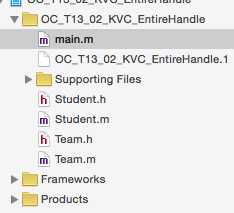标签:
如果要更改对象属性可以通过什么方法达到呢?
(1)通过setter和getter方法。
(2)属性。
(3)直接设置实例变量。
今天学习新的一种方法:键值编码-kvc。通过指定要访问的属性名字的字符串标识符,可以进行类的属性的读取和设置。
键值编码基本调用包括:setValue:forKey:和valueForKey。
栗子:
新建Student类,属性及成员变量:
@interface Student : NSObject { @public NSString * name; @private NSString * hobby; } @property(strong,nonatomic) NSString * address; @property(nonatomic) int age; @end
通过setter和getter方法、属性可以设置属性:
Student * stu1 = [Student new]; stu1->name = @"haha"; NSLog(@"%@",stu1->name); stu1.address = @"street"; //属性可通过点语法设置 stu1.age = 100; NSLog(@"address:%@,age:%d",stu1.address,stu1.age);
***下边通过键值编码kvc设置***
Student * stu1 = [Student new];
[stu1 setValue:@"kvcName" forKey:@"name"];
NSLog(@"kvc设置name:%@",[stu1 valueForKey:@"name"]);
[stu1 setValue:@18 forKey:@"age"]; //int基本型的需要包装成oc对象型的
NSLog(@"kvc设置age:%@",[stu1 valueForKey:@"age"]);
通过kvc也可以设置属性,甚至于private的成员变量也可以设置,Student类中有一个private的成员变量:hobby
//private的属性仍然能够通过kvc设置,所以kvc破坏了面向对象的封装思想 [stu1 setValue:@"read" forKey:@"hobby"]; NSLog(@"%@",[stu1 valueForKey:@"hobby"]);
既然都可以设置属性,那么kvc和其他的有什么区别呢?它的使用场景是什么呢?
1:
key返回NSString类型的字符串。可以单独提出来:
Student * stu1 = [Student new]; NSString * key = @"name"; //变量 灵活 //[stu1 setValue:@"kvcName" forKey:@"name"]; [stu1 setValue:@"kvcName" forKey:key]; NSLog(@"kvc设置name:%@",[stu1 valueForKey:@"name"]);
这样key相当于是一个中间变量,无疑大大增强了灵活性。
2:类似id型对象不能点语法的,那么可以通过kvc设置。如:
id obj = stu1; //id 不能通过点语法设置属性 obj.name = @"hehe"; //报错 [obj setValue:@"idName" forKey:@"name"]; NSLog(@"id设置的name:%@",[obj valueForKey:@"name"]);
kvc首先查找的是setter命名的属性,为证实,重写setter,如果setter被调用则可以证实。
以Student的name成员变量为例,写setter方法:
- (void)setName:(NSString *)newName { NSLog(@"kvc......"); self->name = newName; }
如果被调用则会打印kvc......,
main函数中:
Student * stu1 = [Student new]; NSString * key = @"name"; [stu1 setValue:@"kvcName" forKey:key]; NSLog(@"kvc设置name:%@",[stu1 valueForKey:@"name"]);
打印结果:

验证了。。。。。。如果不存在getter呢?也就是说不能用属性(属性会自动生成setter和getter方法),那么则会在对象内部查找_key或key的实例变量。
以Student的hobby为例,它不是属性,用没有写setter方法,现在声明hobby和_hobby,为了验证写了一个test方法:
@interface Student : NSObject { @public NSString * name; @private NSString * hobby; NSString * _hobby; } @property(strong,nonatomic) NSString * address; @property(nonatomic) int age; - (void)test;
test方法:
- (void)test { NSLog(@"_hobby = %@",self->_hobby); NSLog(@"hobby = %@",self->hobby); }
那么当main中hobby通过kvc设置的时候,会发生什么?
Student * stu1 = [Student new]; [stu1 setValue:@"read" forKey:@"hobby"]; [stu1 test];
按说这是给hobby设置值,打印结果:

结果_hobby上有值,这就证实kvc先查找_key。
注意:使用@property+@synthesize可以自动生成getter和setter,但是如果为其指定非标准的getter和setter,key的搜索则会出现问题。
设想以下情况:添加一个Brother类,Student有一个属性是Brother对象。

@interface Student : NSObject { @public NSString * name; @private NSString * hobby; NSString * _hobby; } @property(strong,nonatomic) NSString * address; @property(nonatomic) int age; //添加brother属性 @property(strong,nonatomic)Brother * brother; - (void)setName:(NSString *)newName; - (void)test; @end
而Brother类下有一个属性broName。现在有这么一个需求:我需要通过Student给brother下的broName赋值。(不是通过brother)
那么代码似乎应该这么写:
Student * stu1 = [Student new]; Brother * bro1 = [Brother new]; stu1.brother = bro1; [stu1 setValue:@"兄弟" forKey:@"bro1.broName"]; NSLog(@"%@",[bro1 valueForKey:@"broName"]); //崩溃
这么写代码崩溃,那该怎么写呢?使用键路径:setValue:forKeyPath:
假设a对象下有一个名为b的属性,而b中包含了名称为c的属性,如果想要从a获取(或设置)c属性的内容需要使用如下路径来描述: b.c (遇到点会解析成路径)
Student * stu1 = [Student new]; Brother * bro1 = [Brother new]; stu1.brother = bro1; [stu1 setValue:@"兄弟" forKeyPath:@"brother.broName"]; NSLog(@"%@",[stu1 valueForKeyPath:@"brother.broName"]);
这样就可以了,上面的代码稍作修改:现在brother下有一个brother对象brotherOld属性,该怎么赋值呢?
@interface Brother : NSObject @property(strong,nonatomic) NSString * broName; @property(strong,nonatomic) Brother * brotherOld; @end
这样相当于通过两层去设置值。
Student * stu1 = [Student new]; Brother * bro1 = [Brother new]; stu1.brother = bro1; Brother * bigBrother = [Brother new]; bro1.brotherOld = bigBrother; [stu1 setValue:@"大兄弟" forKeyPath:@"brother.brotherOld.broName"]; NSLog(@"%@",[stu1 valueForKeyPath:@"brother.brotherOld.broName"]);
为一个不存在的键setValue forKey的话,会报错,比如:
[stu1 setValue:@"mei you zhe ge jian" forKey:@"notExist"]; //崩溃
可以实现setValue:forUndefinedKey:
Student下声明一个字典:NSMutableDictionary * undefinedKeysAndValues可以存到这个字典中(相当于临时容器)
Student.m文件
//以下两个方法一般不重写 -(void)setValue:(id)value forUndefinedKey:(NSString *)key { NSLog(@"呵呵,你所访问的键:%@不存在,你就别想把值:%@放到这个键上了,说的就跟你有这个键似的!",key,value); //[self->undefinedKeysAndValues setObject:value forKey:key]; } -(id)valueForUndefinedKey:(NSString *)key { NSLog(@"对不起,没有这样的键!"); return nil; //return [self->undefinedKeysAndValues objectForKey:key]; } @end
NSDictionary * dict = @{@"aaa":@"11111111",@"bbb":@"22222222222"};
//NSLog(@"%@",[dict objectForKey:@"aaa"]);
NSLog(@"%@",[dict valueForKey:@"aaa"]);
打印结果:
2015-11-06 19:40:30.445 oc-kvc-001[846:61032] 11111111
Program ended with exit code: 0
本来字典的取值是通过objectForKey,现在也能通过valueForKey取值,说明valueForKey是NSobject的方法,字典继承自NSobject
如果对象的某个实例变量为NSArray,而其中存放的又是对象。

Team.h文件:
@interface Team : NSObject @property(strong,nonatomic) NSArray * members; @end
Student.h文件:
@interface Student : NSObject @property(copy,nonatomic) NSString * name; @property(nonatomic) int age; @end
Team下有一个属性为members的数组,members数组中存放的是Student对象。
Student * s1 = [Student new]; s1.name = @"学生甲"; s1.age = 1000; Student * s2 = [Student new]; s2.name = @"学生乙"; s2.age = 28; Student * s3 = [Student new]; s3.name = @"学生丙"; s3.age = 1100; Student * s4 = [Student new]; s4.name = @"学生丁"; s4.age = 1400; NSArray * arr = @[s1,s2,s3,s4]; //对NSArray请求一个键值,则会查询数组中的每一个对象来查找这个键,然后将这些结果重新打包为一个NSArray id ages = [arr valueForKey:@"age"]; NSLog(@"%@",ages);
//可以取最大值、最小值、求和、平均值、个数。 id maxAge = [arr valueForKeyPath:@"@max.age"]; id minAge = [arr valueForKeyPath:@"@min.age"]; id sumAge = [arr valueForKeyPath:@"@sum.age"]; id avgAge = [arr valueForKeyPath:@"@avg.age"]; id count = [arr valueForKeyPath:@"@count"]; NSLog(@"%@,%@,%@,%@,%@",maxAge,minAge,sumAge,avgAge,count); Team * team = [Team new]; team.members = arr; maxAge = [team valueForKeyPath:@"members.@max.age"]; minAge = [team valueForKeyPath:@"members.@min.age"]; sumAge = [team valueForKeyPath:@"members.@sum.age"]; avgAge = [team valueForKeyPath:@"members.@avg.age"]; count = [team valueForKeyPath:@"members.@count"]; NSLog(@"%@,%@,%@,%@,%@",maxAge,minAge,sumAge,avgAge,count);
啊╮(╯▽╰)╭,结束。。。。。。。。
标签:
原文地址:http://www.cnblogs.com/yingu/p/4943535.html